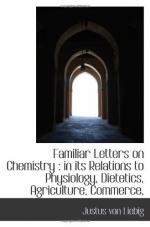The method by which it is obtained sufficiently proves that it is insoluble in water; although we cannot doubt that it was originally dissolved in the vegetable juice, from which it afterwards separated, exactly as fibrine does from blood.
The second nitrogenised compound remains dissolved in the juice after the separation of the fibrine. It does not separate from the juice at the ordinary temperature, but is instantly coagulated when the liquid containing it is heated to the boiling point.
When the clarified juice of nutritious vegetables, such as cauliflower, asparagus, mangelwurzel, or turnips, is made to boil, a coagulum is formed, which it is absolutely impossible to distinguish from the substance which separates as a coagulum, when the serum of blood, or the white of an egg, diluted with water, are heated to the boiling point. This is vegetable albumen. It is found in the greatest abundance in certain seeds, in nuts, almonds, and others, in which the starch of the gramineae is replaced by oil.
The third nitrogenised constituent of the vegetable food of animals is vegetable caseine. It is chiefly found in the seeds of peas, beans, lentils, and similar leguminous seeds. Like vegetable albumen, it is soluble in water, but differs from it in this, that its solution is not coagulated by heat. When the solution is heated or evaporated, a skin forms on its surface, and the addition of an acid causes a coagulum, just as in animal milk.
These three nitrogenised compounds, vegetable fibrine, albumen, and caseine, are the true nitrogenised constituents of the food of graminivorous animals; all other nitrogenised compounds occurring in plants, are either rejected by animals, as in the case of the characteristic principles of poisonous and medicinal plants, or else they occur in the food in such very small proportion, that they cannot possibly contribute to the increase of mass in the animal body.
The chemical analysis of these three substances has led to the very interesting result that they contain the same organic elements, united in the same proportion by weight; and, what is still more remarkable, that they are identical in composition with the chief constituents of blood, animal fibrine, and albumen. They all three dissolve in concentrated muriatic acid with the same deep purple colour, and even in their physical characters, animal fibrine and albumen are in no respect different from vegetable fibrine and albumen. It is especially to be noticed, that by the phrase, identity of composition, we do not here intend mere similarity, but that even in regard to the presence and relative amount of sulphur, phosphorus, and phosphate of lime, no difference can be observed.




